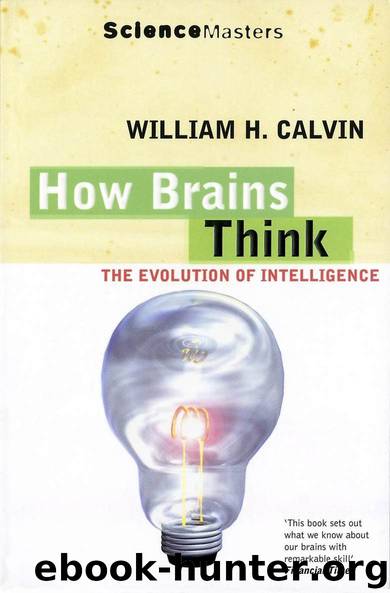How Brains Think (SCIENCE MASTERS) by William H. Calvin

Author:William H. Calvin [Calvin, William H.]
Language: eng
Format: epub
ISBN: 9781780227719
Publisher: Orion
Published: 2013-12-31T00:00:00+00:00
Ballistic movements (so named because beyond a certain point there is no opportunity to modify the command) require a surprising amount of planning, compared to most movements. They also likely require lots of clones of the movement program.
For sudden limb movements lasting less than about an eighth of a second, feedback corrections are largely ineffective, because reaction times are so long. Nerves conduct too slowly, and decisions aren’t made quickly enough; feedback might help plan for next time, if the target hasn’t run away by then, but it’s no help in real time. For the last one-eighth second of clubbing, hammering, throwing, and kicking, the brain has to plan every detail of the movement and then spit it out, rather like punching a roll for a player piano and then letting it roll.
We need nearly complete advance planning for ballistic movements during ‘get set,’ with no reliance on feedback. Hammering requires planning the exact sequence of activation for dozens of muscles. In the case of throwing, the problem is difficult for an additional reason: there is a launch window – a range of times when the projectile can be released and still hit the target. Release occurs shortly after the velocity peaks, as the projectile sails out of the decelerating hand. Getting this peak velocity to occur at exactly the right time, at the appropriate angle from the horizontal, is the trick.
Given the launch-window problems, you can see why planning is so difficult for human ballistic movements. Launch windows depend on how far away the target is, and on how big it is. Let’s say that, eight tries out of ten, you can hit a rabbit-sized target from the length of one parallel parking space – which implies a launch window of 11 milliseconds. Hitting the same target from twice the distance with equal reliability means releasing within a launch window about eight times narrower, 1.4 msec. Neurons are not exactly atomic clocks when it comes to timing accuracy; there is a lot of jitter when impulses are produced, enough so that any one neuron would have trouble hitting the broad side of a barn if it had to time the ball’s release all by itself.
Happily, many noisy neurons are better than a few – so long as they’re all ‘doing their own thing’ and thereby making their own mistakes. Combining them can average out some of the noise. You can see this principle at work in the heart, making the heartbeat more regular. A fourfold increase in the number of pacemaker cells serves to cut the heartbeat jitter in half. To reduce ballistic release jitter eightfold requires averaging the output of 64 times as many noisy neurons as you needed to program the original throw. If you want to hit that same rabbit-sized target at three times the distance with that same eight-out-of-ten-times reliability, count on needing to recruit a lot of helpers: you will require 729 times as many neurons as the number sufficient for generating your standard short throw.
Download
This site does not store any files on its server. We only index and link to content provided by other sites. Please contact the content providers to delete copyright contents if any and email us, we'll remove relevant links or contents immediately.
| Administration & Medicine Economics | Allied Health Professions |
| Basic Sciences | Dentistry |
| History | Medical Informatics |
| Medicine | Nursing |
| Pharmacology | Psychology |
| Research | Veterinary Medicine |
The Art of Thinking Clearly by Rolf Dobelli(10137)
The 5 Love Languages: The Secret to Love That Lasts by Gary Chapman(9508)
Mindhunter: Inside the FBI's Elite Serial Crime Unit by John E. Douglas & Mark Olshaker(9100)
Becoming Supernatural by Dr. Joe Dispenza(8035)
The Road Less Traveled by M. Scott Peck(7472)
Nudge - Improving Decisions about Health, Wealth, and Happiness by Thaler Sunstein(7456)
Mastermind: How to Think Like Sherlock Holmes by Maria Konnikova(7160)
Enlightenment Now: The Case for Reason, Science, Humanism, and Progress by Steven Pinker(7083)
Win Bigly by Scott Adams(7032)
The Way of Zen by Alan W. Watts(6449)
Factfulness: Ten Reasons We're Wrong About the World – and Why Things Are Better Than You Think by Hans Rosling(4624)
The State of Affairs by Esther Perel(4587)
Gerald's Game by Stephen King(4511)
Man's Search for Meaning by Viktor Frankl(4350)
The Confidence Code by Katty Kay(4155)
Thinking in Bets by Annie Duke(4118)
Hidden Persuasion: 33 psychological influence techniques in advertising by Marc Andrews & Matthijs van Leeuwen & Rick van Baaren(3414)
The Healing Self by Deepak Chopra(3399)
The Worm at the Core by Sheldon Solomon(3395)
